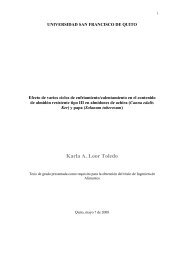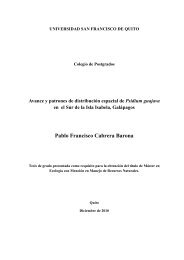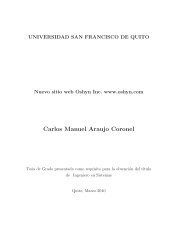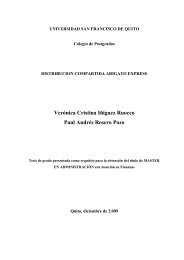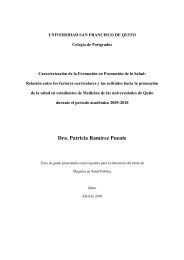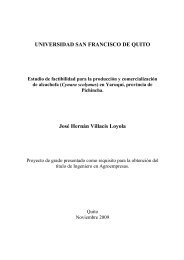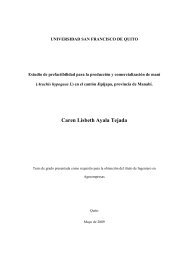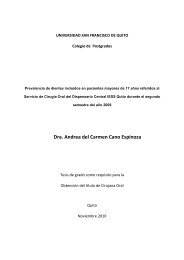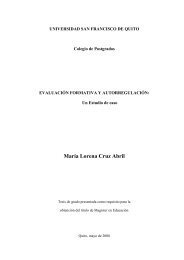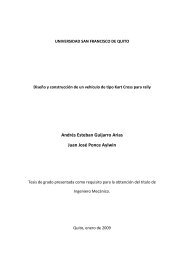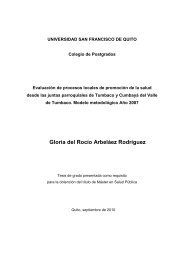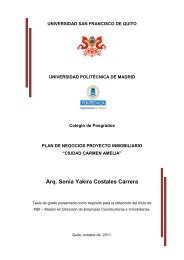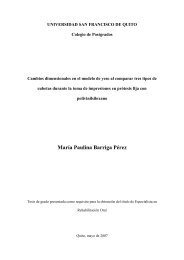Myriam Elizabeth Saavedra López - Repositorio Digital USFQ ...
Myriam Elizabeth Saavedra López - Repositorio Digital USFQ ...
Myriam Elizabeth Saavedra López - Repositorio Digital USFQ ...
Create successful ePaper yourself
Turn your PDF publications into a flip-book with our unique Google optimized e-Paper software.
for r ≥ 0 and in the general d-dimensional case, g (r) = K′ (r)<br />
dπdrd−1 for r ≥ 0.<br />
When r is large, the lim g (r) = 1, means there is independent between the two compared points<br />
r→∞<br />
for large r. To be more precise, for this equation, the point process must have some distributional<br />
properties (called mixing properties).<br />
If there is a finite distance rcorr with g (r) = 1 for r ≥ rcorr then rcorr is called range of correlation.<br />
This means that there are no correlations between point positions at larger distances.<br />
It is clear that in the Poisson process or CSR case g (r) = 1 for r ≥ 0, i.e. which means that the<br />
location of any point is entirely independent of the locations of the other points. Again, in typical<br />
non-Poisson cases a characteristic behaviour of g (r) may be found in the cluster process if g (r) > 1<br />
and regular process if g (r) < 1 , in particular for small radii in both cases.<br />
The Second Moment Characteristics are related to statistical concepts such as spatial autocorrelation<br />
and semi-variogram because all these functions study the distances (space) between variables (spatial<br />
data) and what is it happening between these variables when these distances are short or long (in-<br />
teraction and/or dependence). Therefore all these functions support the first law of geography that<br />
“everything is related to everything else, but near things are more related than distant things” (Waldo<br />
Tobler). See the following descriptions:<br />
1. Spatial Autocorrelation, according to Zuur, states that pairs of subjects (points) that are close<br />
to each other are more likely to have values that are more similar, and pair of subjects far apart<br />
forms each other are more likely to have values that are less similar. It is important to mention<br />
that the Function Ripley’s K is one of the indices of spatial autocorrelation.<br />
2. According to Cressei (1993, 58), semi-variogram has been called the variogram divided by 2,<br />
by Matheron (1962), therefore they are commonly referenced. The semi-variogram is a plot of<br />
semivariance as a function of distance. The semi-variance measures the dissimilarity of sub-<br />
jects within a single variable, compared to covariance which measures the similarity of one or<br />
more variables. It is not normalized and values are not as constrained as are most correlation<br />
coefficients (Zuur).<br />
3.6 Corrected Estimates<br />
According to Illian et al (2008, 180-183), the spatial statistics analysis with stationary point processes<br />
faces a difficult problem at its window edges: data are given for a bounded observation window W<br />
only, but the pattern is (implicitly) assumed to be infinite and the summary characteristic to be<br />
estimated is defined independently of W and should not show any traces of W . However, natural<br />
16



